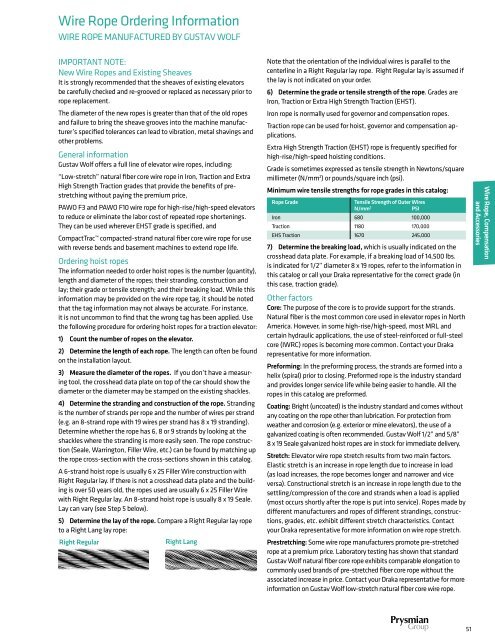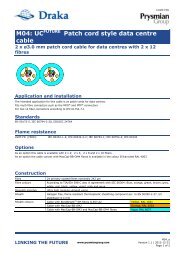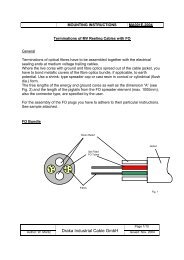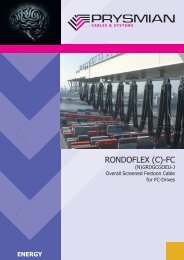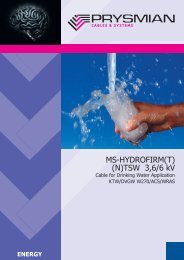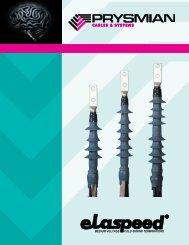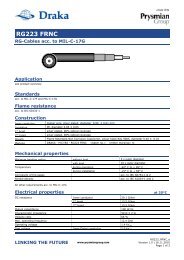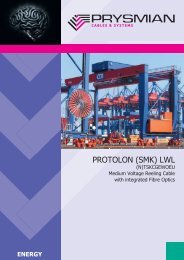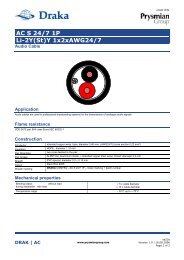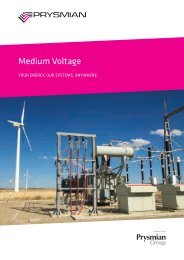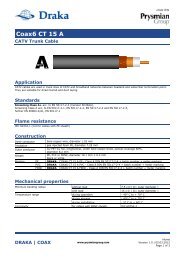wire rope guide - Prysmian Group
wire rope guide - Prysmian Group
wire rope guide - Prysmian Group
You also want an ePaper? Increase the reach of your titles
YUMPU automatically turns print PDFs into web optimized ePapers that Google loves.
Wire Rope Ordering Information<br />
WIRE ROPE MANUFACTURED BY GUSTAv WOLF<br />
IMPORTANT NOTE:<br />
New Wire Ropes and Existing Sheaves<br />
It is strongly recommended that the sheaves of existing elevators<br />
be carefully checked and re-grooved or replaced as necessary prior to<br />
<strong>rope</strong> replacement.<br />
The diameter of the new <strong>rope</strong>s is greater than that of the old <strong>rope</strong>s<br />
and failure to bring the sheave grooves into the machine manufacturer’s<br />
specified tolerances can lead to vibration, metal shavings and<br />
other problems.<br />
General information<br />
Gustav Wolf offers a full line of elevator <strong>wire</strong> <strong>rope</strong>s, including:<br />
“Low-stretch” natural fiber core <strong>wire</strong> <strong>rope</strong> in Iron, Traction and Extra<br />
High Strength Traction grades that provide the benefits of prestretching<br />
without paying the premium price,<br />
PAWO F3 and PAWO F10 <strong>wire</strong> <strong>rope</strong> for high-rise/high-speed elevators<br />
to reduce or eliminate the labor cost of repeated <strong>rope</strong> shortenings.<br />
They can be used wherever EHST grade is specified, and<br />
CompactTrac compacted-strand natural fiber core <strong>wire</strong> <strong>rope</strong> for use<br />
with reverse bends and basement machines to extend <strong>rope</strong> life.<br />
Ordering hoist <strong>rope</strong>s<br />
The information needed to order hoist <strong>rope</strong>s is the number (quantity),<br />
length and diameter of the <strong>rope</strong>s; their stranding, construction and<br />
lay; their grade or tensile strength; and their breaking load. While this<br />
information may be provided on the <strong>wire</strong> <strong>rope</strong> tag, it should be noted<br />
that the tag information may not always be accurate. For instance,<br />
it is not uncommon to find that the wrong tag has been applied. Use<br />
the following procedure for ordering hoist <strong>rope</strong>s for a traction elevator:<br />
1) Count the number of <strong>rope</strong>s on the elevator.<br />
2) Determine the length of each <strong>rope</strong>. The length can often be found<br />
on the installation layout.<br />
3) Measure the diameter of the <strong>rope</strong>s. If you don’t have a measuring<br />
tool, the crosshead data plate on top of the car should show the<br />
diameter or the diameter may be stamped on the existing shackles.<br />
4) Determine the stranding and construction of the <strong>rope</strong>. Stranding<br />
is the number of strands per <strong>rope</strong> and the number of <strong>wire</strong>s per strand<br />
(e.g. an 8-strand <strong>rope</strong> with 19 <strong>wire</strong>s per strand has 8 x 19 stranding).<br />
Determine whether the <strong>rope</strong> has 6, 8 or 9 strands by looking at the<br />
shackles where the stranding is more easily seen. The <strong>rope</strong> construction<br />
(Seale, Warrington, Filler Wire, etc.) can be found by matching up<br />
the <strong>rope</strong> cross-section with the cross-sections shown in this catalog.<br />
A 6-strand hoist <strong>rope</strong> is usually 6 x 25 Filler Wire construction with<br />
Right Regular lay. If there is not a crosshead data plate and the building<br />
is over 50 years old, the <strong>rope</strong>s used are usually 6 x 25 Filler Wire<br />
with Right Regular lay. An 8-strand hoist <strong>rope</strong> is usually 8 x 19 Seale.<br />
Lay can vary (see Step 5 below).<br />
5) Determine the lay of the <strong>rope</strong>. Compare a Right Regular lay <strong>rope</strong><br />
to a Right Lang lay <strong>rope</strong>:<br />
Right Regular Right Lang<br />
Note that the orientation of the individual <strong>wire</strong>s is parallel to the<br />
centerline in a Right Regular lay <strong>rope</strong>. Right Regular lay is assumed if<br />
the lay is not indicated on your order.<br />
6) Determine the grade or tensile strength of the <strong>rope</strong>. Grades are<br />
Iron, Traction or Extra High Strength Traction (EHST).<br />
Iron <strong>rope</strong> is normally used for governor and compensation <strong>rope</strong>s.<br />
Traction <strong>rope</strong> can be used for hoist, governor and compensation applications.<br />
Extra High Strength Traction (EHST) <strong>rope</strong> is frequently specified for<br />
high-rise/high-speed hoisting conditions.<br />
Grade is sometimes expressed as tensile strength in Newtons/square<br />
millimeter (N/mm2 ) or pounds/square inch (psi).<br />
Minimum <strong>wire</strong> tensile strengths for <strong>rope</strong> grades in this catalog:<br />
Rope Grade Tensile Strength of Outer Wires<br />
N/mm2 PSI<br />
Iron 680 100,000<br />
Traction 1180 170,000<br />
EHS Traction 1670 245,000<br />
7) Determine the breaking load, which is usually indicated on the<br />
crosshead data plate. For example, if a breaking load of 14,500 lbs.<br />
is indicated for 1/2” diameter 8 x 19 <strong>rope</strong>s, refer to the information in<br />
this catalog or call your Draka representative for the correct grade (in<br />
this case, traction grade).<br />
Other factors<br />
Core: The purpose of the core is to provide support for the strands.<br />
Natural fiber is the most common core used in elevator <strong>rope</strong>s in North<br />
America. However, in some high-rise/high-speed, most MRL and<br />
certain hydraulic applications, the use of steel-reinforced or full-steel<br />
core (IWRC) <strong>rope</strong>s is becoming more common. Contact your Draka<br />
representative for more information.<br />
Preforming: In the preforming process, the strands are formed into a<br />
helix (spiral) prior to closing. Preformed <strong>rope</strong> is the industry standard<br />
and provides longer service life while being easier to handle. All the<br />
<strong>rope</strong>s in this catalog are preformed.<br />
Coating: Bright (uncoated) is the industry standard and comes without<br />
any coating on the <strong>rope</strong> other than lubrication. For protection from<br />
weather and corrosion (e.g. exterior or mine elevators), the use of a<br />
galvanized coating is often recommended. Gustav Wolf 1/2” and 5/8”<br />
8 x 19 Seale galvanized hoist <strong>rope</strong>s are in stock for immediate delivery.<br />
Stretch: Elevator <strong>wire</strong> <strong>rope</strong> stretch results from two main factors.<br />
Elastic stretch is an increase in <strong>rope</strong> length due to increase in load<br />
(as load increases, the <strong>rope</strong> becomes longer and narrower and vice<br />
versa). Constructional stretch is an increase in <strong>rope</strong> length due to the<br />
settling/compression of the core and strands when a load is applied<br />
(most occurs shortly after the <strong>rope</strong> is put into service). Ropes made by<br />
different manufacturers and <strong>rope</strong>s of different strandings, constructions,<br />
grades, etc. exhibit different stretch characteristics. Contact<br />
your Draka representative for more information on <strong>wire</strong> <strong>rope</strong> stretch.<br />
Prestretching: Some <strong>wire</strong> <strong>rope</strong> manufacturers promote pre-stretched<br />
<strong>rope</strong> at a premium price. Laboratory testing has shown that standard<br />
Gustav Wolf natural fiber core <strong>rope</strong> exhibits comparable elongation to<br />
commonly used brands of pre-stretched fiber core <strong>rope</strong> without the<br />
associated increase in price. Contact your Draka representative for more<br />
information on Gustav Wolf low-stretch natural fiber core <strong>wire</strong> <strong>rope</strong>.<br />
51<br />
Wire Rope, Compensation<br />
and Accessories
Wire Rope, Compensation<br />
and Accessories<br />
52<br />
Wire Rope Ordering Information<br />
WIRE ROPE MANUFACTURED BY GUSTAv WOLF<br />
Ordering governor and/or compensation <strong>rope</strong>s<br />
The ordering procedure is similar to hoist <strong>rope</strong>s but you may have to<br />
rely on the <strong>rope</strong> tag to a greater degree because there is no crosshead<br />
data plate for governor or compensation <strong>rope</strong>s. However:<br />
1) Measure the diameter of the <strong>rope</strong>s. Use a caliper, micrometer or<br />
Go/No Go gauge.<br />
2) Go to the shackles and confirm the stranding (6 or 8) of the <strong>rope</strong>s.<br />
Almost all compensation and governor <strong>rope</strong>s have 8 strands (refer to<br />
the <strong>rope</strong> cross-sections shown in this catalog).<br />
Look at the <strong>rope</strong> tag to determine breaking strength and then refer to<br />
the information in this catalog or contact your Draka representative<br />
for the correct grade (Iron or Traction).<br />
3) Consider the <strong>rope</strong> grade or tensile strength. Governor and compensation<br />
<strong>rope</strong>s are either Iron or Traction - never Extra High Strength<br />
Traction (EHST).<br />
4) The lay of governor and compensation <strong>rope</strong>s is always Right<br />
Regular and never Right Lang.<br />
Other factors:<br />
Preformed <strong>rope</strong> is always preferred for its longer life and ease of<br />
installation.<br />
Replace all governor and compensation <strong>rope</strong>s with preformed <strong>rope</strong>s.<br />
Handling of <strong>wire</strong> <strong>rope</strong>s prior to and during installation<br />
Reels are best transported on the job site by rolling on a clean flat<br />
surface or by lifting from a pipe in the reel center hole.<br />
Wire <strong>rope</strong> should be stored indoors, off the ground and covered to<br />
protect it from moisture, dirt, dust, sunlight, etc.<br />
Care must be taken to unroll and not laterally pull <strong>wire</strong> <strong>rope</strong> when<br />
paying it off the reel. kinking and dragging <strong>rope</strong>s over sharp edges<br />
must be avoided.<br />
Ropes must be prevented from rotating during installation since<br />
free-hanging <strong>rope</strong>s will untwist under their own weight. The use of<br />
reeving splices is recommended and these are available on page 60 of<br />
this catalog.<br />
Loose <strong>rope</strong> ends should always be seized or secured with cable bands<br />
to prevent untwisting. Cable bands are available on page 60 of this<br />
catalog.<br />
The installer should continually inspect <strong>wire</strong> <strong>rope</strong> during installation<br />
to identify any areas which may have been damaged in shipment or<br />
while in storage on the job site. Per ASME A17.1b-2009/CSA B44b-09<br />
8.6.3.2 and ASME A17.6-2010 1.10.5, where one suspension <strong>rope</strong> has<br />
been damaged during installation or acceptance testing prior to being<br />
subjected to elevator service, it shall be permissible to replace a single<br />
damaged <strong>rope</strong> with a new <strong>rope</strong>, provided that the requirements of<br />
8.6.3.2.1 through 8.6.3.2.6 and 1.10.4.4 and 1.10.5.1 through 1.10.5.6<br />
respectively are met.<br />
Tensioning<br />
It is important to equally tension all the hoist <strong>rope</strong>s immediately after<br />
installation and during subsequent inspections in order to avoid differential<br />
wear of sheave grooves and <strong>rope</strong>s and to extend <strong>rope</strong> service<br />
life.<br />
P<strong>rope</strong>rly tensioned <strong>rope</strong>s result when each <strong>rope</strong> carries within 10% an<br />
equal percentage of the total load. Ropes with greater tension/load<br />
will press harder into the sheave grooves resulting in increased overall<br />
<strong>rope</strong> wear while <strong>rope</strong>s with lesser tension/load will slide through the<br />
sheave grooves causing increased crown and sheave wear.<br />
Some in the industry use techniques such as “tuning/plucking” or a<br />
torque wrench to determine tensioning but the results are rough at<br />
best.<br />
Today, highly accurate electronic <strong>rope</strong> tension measuring devices are<br />
available which allow the quick and accurate checking of tension.<br />
Tension measuring devices are available on pages 61 and 93 of this<br />
catalog.<br />
Field lubrication policy<br />
Draka strongly recommends an annual lubrication application every<br />
spring. Ropes should be field lubricated prior to summer and the<br />
increased temperature and humidity it brings. Summertime is when<br />
the air conditioners in the machine rooms and offices are operating.<br />
Condensation caused by the combination of an air conditioned<br />
machine room and a humid hoistway must be kept from entering<br />
the <strong>rope</strong> core. Governor <strong>rope</strong>s should NEVER be field lubricated. See<br />
Draka Tech Tip #6 for detailed lubrication instructions.<br />
Wire <strong>rope</strong> may be payed<br />
off a reel supported by jack<br />
stands with a helper using a<br />
board as a brake...<br />
...or by paying it off a coil as<br />
the helper rotates it...<br />
...or by paying it off a bollard<br />
as the helper rotates it.<br />
Use these tools to cut and measure <strong>wire</strong> <strong>rope</strong>. See page 93 for details.<br />
Impact cutter Hydraulic cutter Ratchet cutter Rope gauge Quick-Balance<br />
tension meter<br />
Digital caliper


